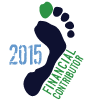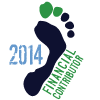I've never been a runner, but have always liked the idea of just walking out the front door and going for a run. Due to ankle or knee pain while running, I always quit after a few runs thinking I was just torturing myself trying to make it enjoyable. After reading Born to Run and doing some research online, I started out a few months ago running in VFF's - I just didn't think the barefoot thing was for me. I had a little adjustment period to the toe part of the shoes, but otherwise had a pain free start. Then I started running on trails (which I truly love), and started trying out different minimalist shoes. I've loved it and remained pain free, but have not really found comfortable shoes. Meanwhile I've been reading up on barefoot running and lurking around this forum. (Husband looking over shoulder: "Are you going to run BAREFOOT now?" Me: "Oh no, I'm just reading about the minimalist part.")
My last attempt at footwear was invisible shoes, and while the material under my foot was fine, the string between my toes drove me nuts no matter how I adjusted the tying, and I ended up turning around and going back home after just a quarter mile. Walking back home, the string irritated me even more so I just took off the shoes. What a relief! Walking without them was such a relief, so I tried running! Oh my gosh! What have I been wearing shoes for? Barefoot is the best! No shoes shifting on my feet, no ties, laces or straps to drive me nuts, and I could truly feel how my feet were hitting the pavement. I'm a total convert.
Now for the conversion. How does everyone start out? On pavement? On trails? I have my first 5 mile race on trails the end of February, and I'm pretty sure I can't make that in bare feet by then, can I? Someone please tell me I could get up to that, because I REALLY want to. (but don't blow smoke up my a**, I still want to be realistic). I was up to that in my VFFs, but I know I've got to work up to that barefoot now. It's pretty cold and rainy here (our first snowstorm is just melting off), and the trail for the race is partly everything - rocky, muddy, downed branches, leaves hiding terrain underneath. Is it better to start out on pavement? On trails? Should I just plan on wearing shoes for the race? I'm just so stoked about running barefoot, I know I need to hold myself back so I don't over do it. :bigsmile:
Any help or suggestions would be greatly appreciated.
My last attempt at footwear was invisible shoes, and while the material under my foot was fine, the string between my toes drove me nuts no matter how I adjusted the tying, and I ended up turning around and going back home after just a quarter mile. Walking back home, the string irritated me even more so I just took off the shoes. What a relief! Walking without them was such a relief, so I tried running! Oh my gosh! What have I been wearing shoes for? Barefoot is the best! No shoes shifting on my feet, no ties, laces or straps to drive me nuts, and I could truly feel how my feet were hitting the pavement. I'm a total convert.
Now for the conversion. How does everyone start out? On pavement? On trails? I have my first 5 mile race on trails the end of February, and I'm pretty sure I can't make that in bare feet by then, can I? Someone please tell me I could get up to that, because I REALLY want to. (but don't blow smoke up my a**, I still want to be realistic). I was up to that in my VFFs, but I know I've got to work up to that barefoot now. It's pretty cold and rainy here (our first snowstorm is just melting off), and the trail for the race is partly everything - rocky, muddy, downed branches, leaves hiding terrain underneath. Is it better to start out on pavement? On trails? Should I just plan on wearing shoes for the race? I'm just so stoked about running barefoot, I know I need to hold myself back so I don't over do it. :bigsmile:
Any help or suggestions would be greatly appreciated.




















